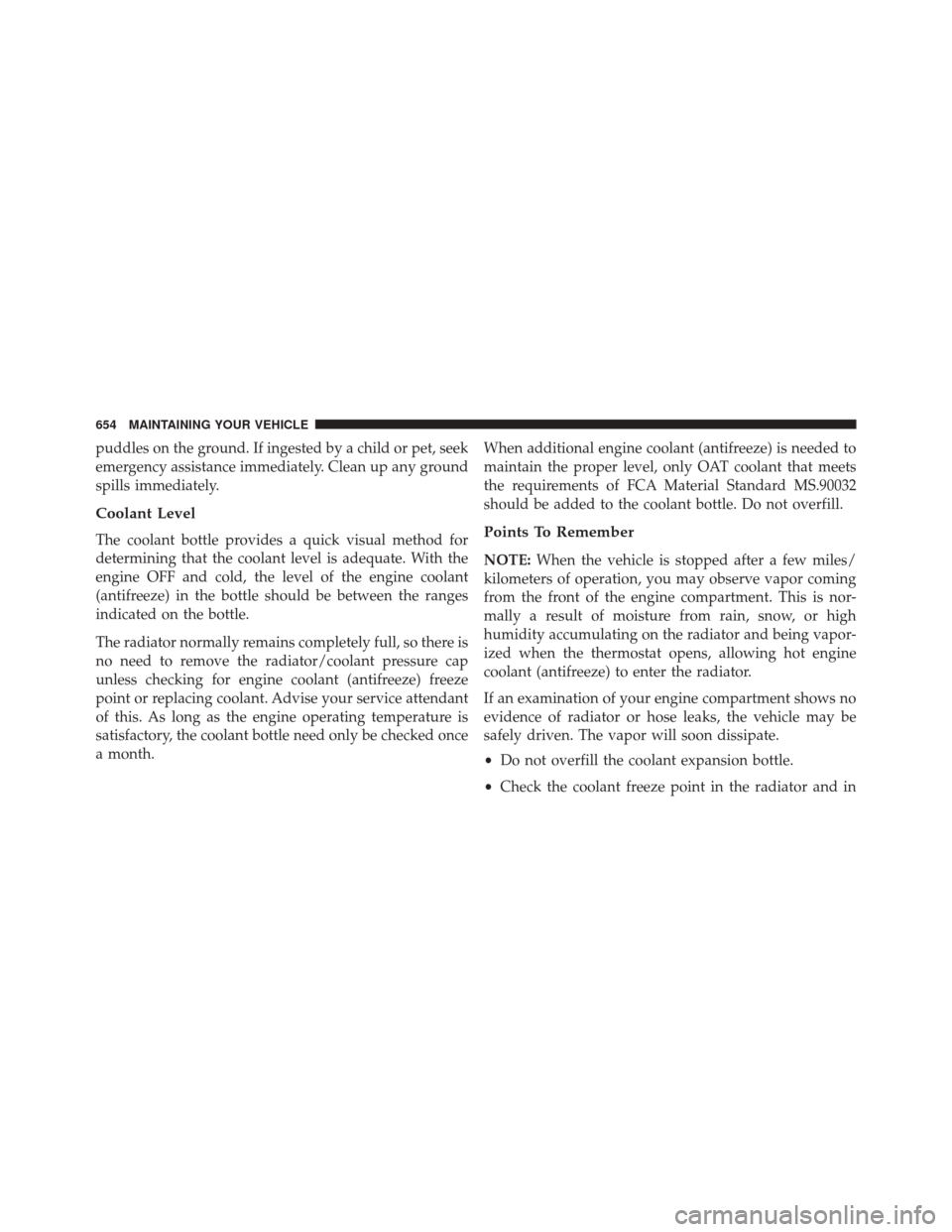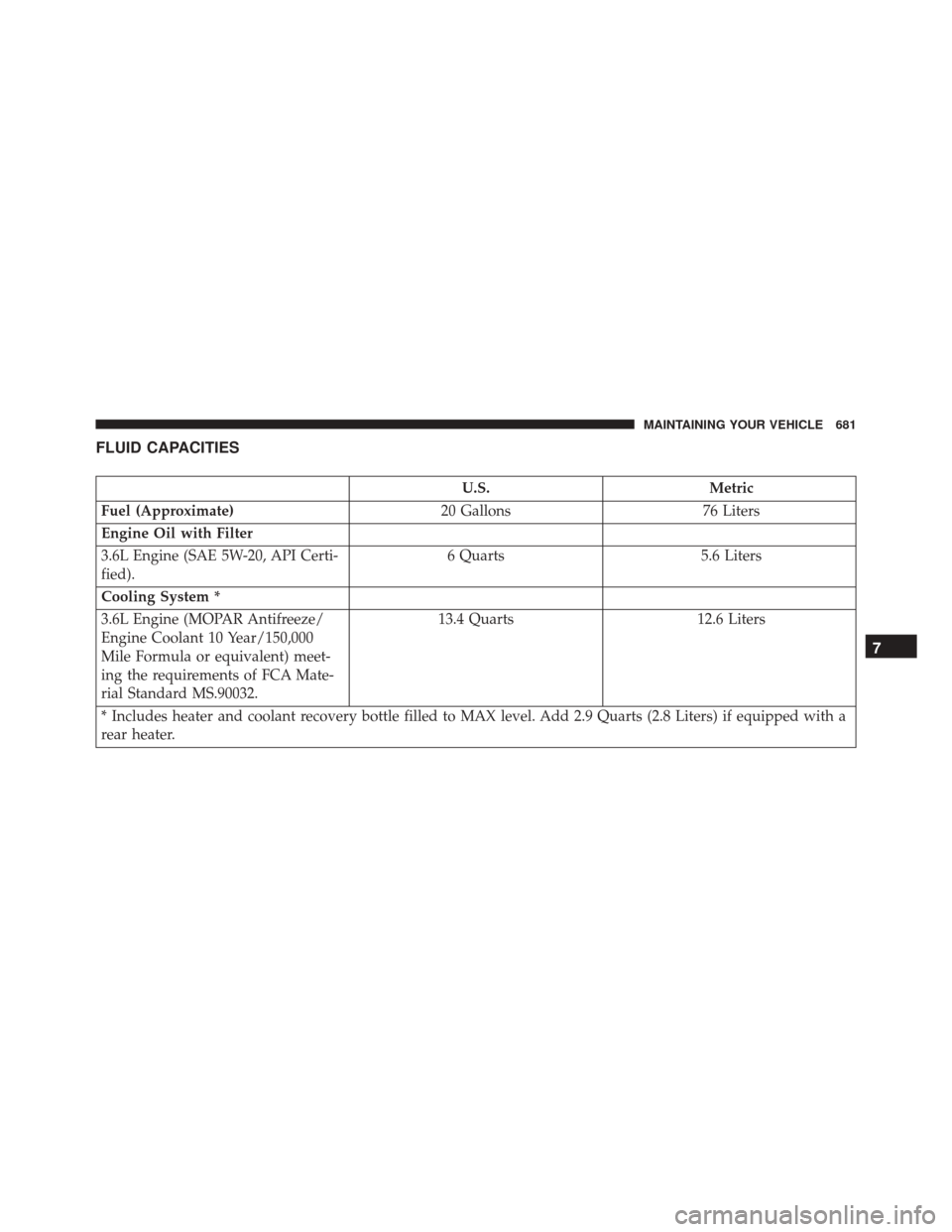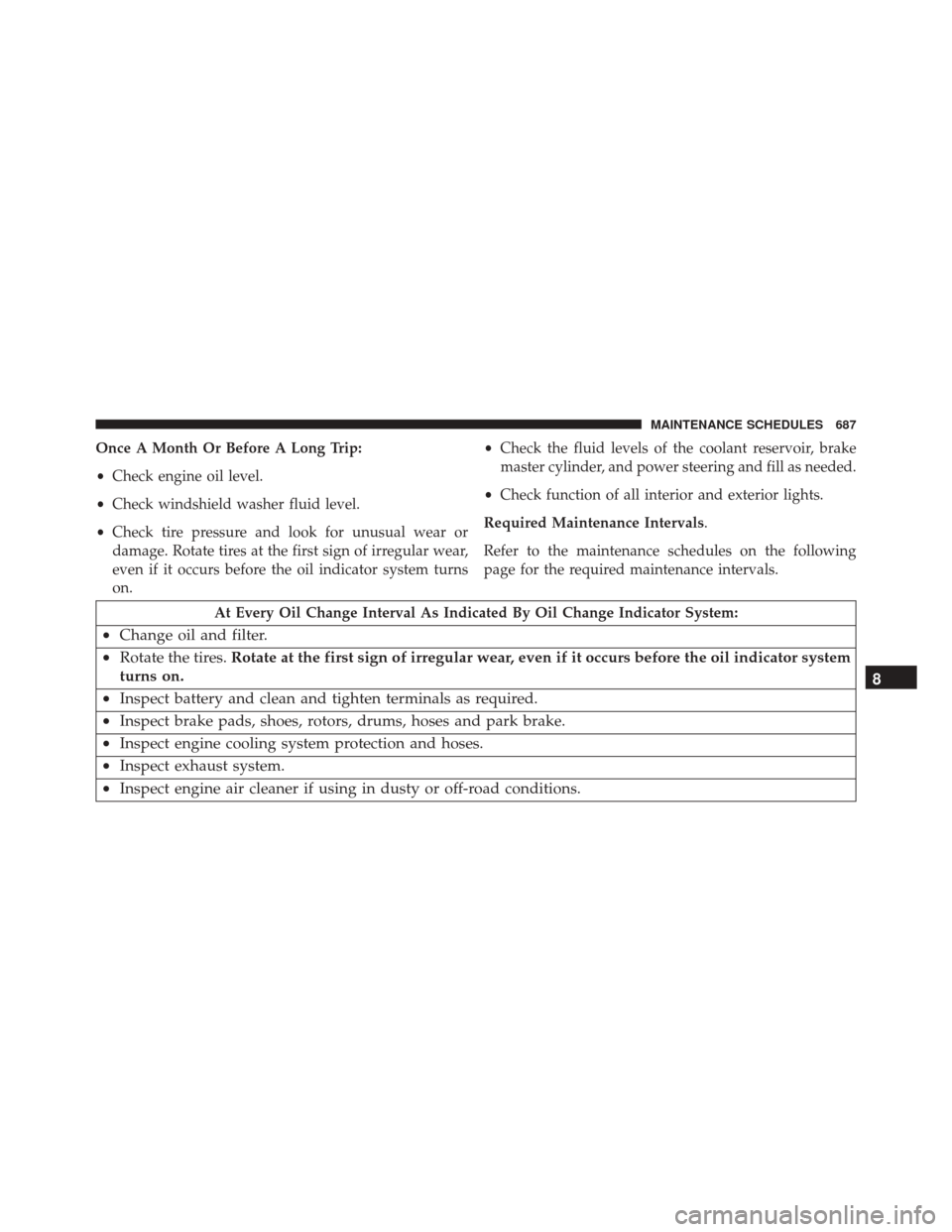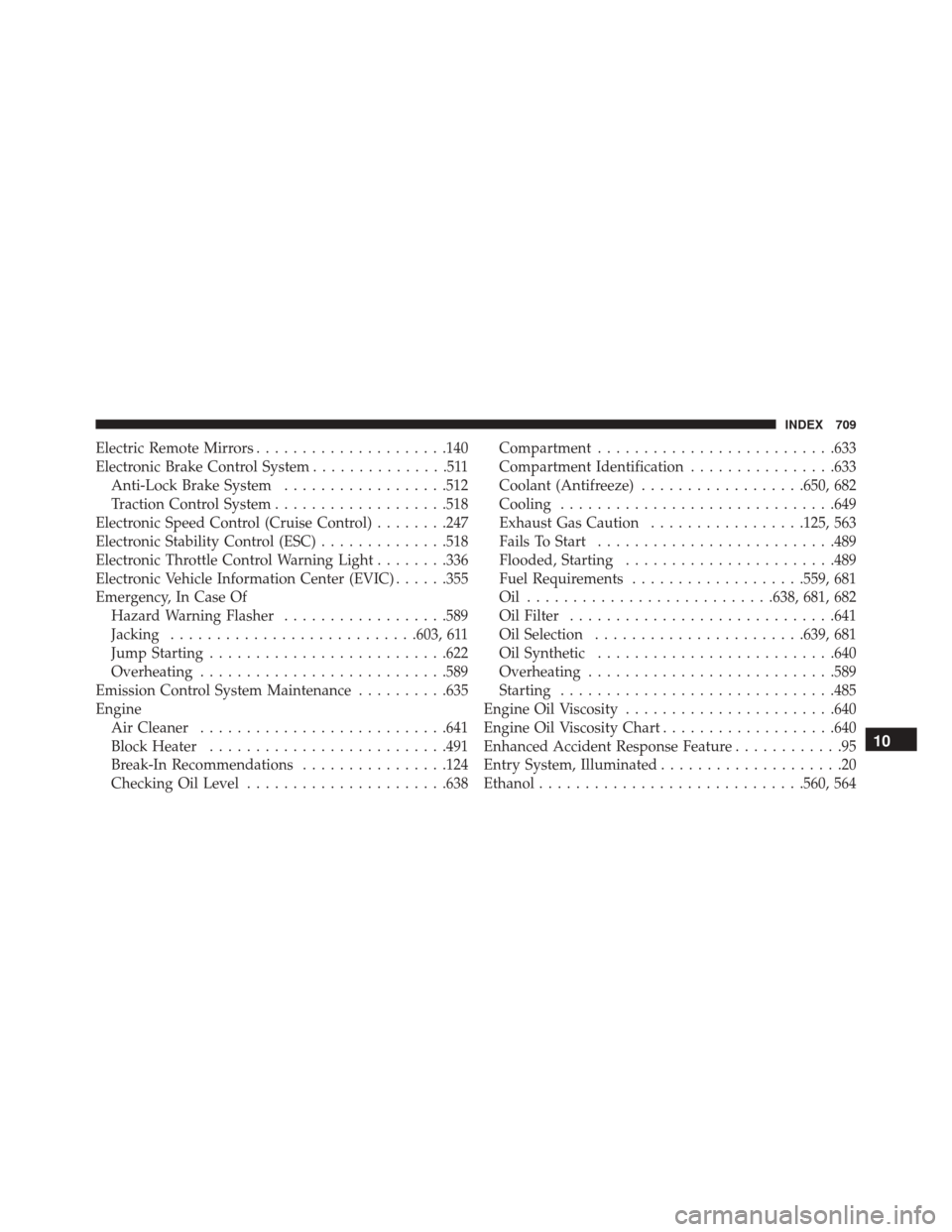2016 CHRYSLER TOWN AND COUNTRY coolant level
[x] Cancel search: coolant levelPage 654 of 727

miles (240,000 km) before replacement. To prevent reduc-
ing this extended maintenance period, it is important that
you use the same engine coolant (OAT coolant conform-
ing to MS.90032) throughout the life of your vehicle.
Please review these recommendations for using Organic
Additive Technology (OAT) engine coolant (antifreeze)
that meets the requirements of FCA Material Standard
MS.90032. When adding engine coolant (antifreeze):
•We recommend using MOPAR Antifreeze/Coolant 10
Year/150,000 Mile Formula OAT (Organic Additive
Technology) that meets the requirements of FCA Ma-
terial Standard MS.90032.
• Mix a minimum solution of 50% OAT engine coolant
that meets the requirements of FCA Material Standard
MS.90032 and distilled water. Use higher concentra-
tions (not to exceed 70%) if temperatures below �34°F
(�37°C) are anticipated. •
Use only high purity water such as distilled or deion-
ized water when mixing the water/engine coolant
(antifreeze) solution. The use of lower quality water
will reduce the amount of corrosion protection in the
engine cooling system.
Please note that it is the owner’s responsibility to main-
tain the proper level of protection against freezing ac-
cording to the temperatures occurring in the area where
the vehicle is operated.
NOTE:
• Some vehicles require special tools to add coolant
properly. Failure to fill these systems properly could
lead to severe internal engine damage. If any coolant is
needed to be added to the system, please contact your
local authorized dealer.
• Mixing engine coolant (antifreeze) types is not recom-
mended and can result in cooling system damage. If
652 MAINTAINING YOUR VEHICLE
Page 656 of 727

puddles on the ground. If ingested by a child or pet, seek
emergency assistance immediately. Clean up any ground
spills immediately.
Coolant Level
The coolant bottle provides a quick visual method for
determining that the coolant level is adequate. With the
engine OFF and cold, the level of the engine coolant
(antifreeze) in the bottle should be between the ranges
indicated on the bottle.
The radiator normally remains completely full, so there is
no need to remove the radiator/coolant pressure cap
unless checking for engine coolant (antifreeze) freeze
point or replacing coolant. Advise your service attendant
of this. As long as the engine operating temperature is
satisfactory, the coolant bottle need only be checked once
a month.When additional engine coolant (antifreeze) is needed to
maintain the proper level, only OAT coolant that meets
the requirements of FCA Material Standard MS.90032
should be added to the coolant bottle. Do not overfill.Points To Remember
NOTE:
When the vehicle is stopped after a few miles/
kilometers of operation, you may observe vapor coming
from the front of the engine compartment. This is nor-
mally a result of moisture from rain, snow, or high
humidity accumulating on the radiator and being vapor-
ized when the thermostat opens, allowing hot engine
coolant (antifreeze) to enter the radiator.
If an examination of your engine compartment shows no
evidence of radiator or hose leaks, the vehicle may be
safely driven. The vapor will soon dissipate.
• Do not overfill the coolant expansion bottle.
• Check the coolant freeze point in the radiator and in
654 MAINTAINING YOUR VEHICLE
Page 683 of 727

FLUID CAPACITIES
U.S.Metric
Fuel (Approximate) 20 Gallons76 Liters
Engine Oil with Filter
3.6L Engine (SAE 5W-20, API Certi-
fied). 6 Quarts
5.6 Liters
Cooling System *
3.6L Engine (MOPAR Antifreeze/
Engine Coolant 10 Year/150,000
Mile Formula or equivalent) meet-
ing the requirements of FCA Mate-
rial Standard MS.90032. 13.4 Quarts
12.6 Liters
* Includes heater and coolant recovery bottle filled to MAX level. Add 2.9 Quarts (2.8 Liters) if equipped with a
rear heater.
7
MAINTAINING YOUR VEHICLE 681
Page 689 of 727

Once A Month Or Before A Long Trip:
•Check engine oil level.
• Check windshield washer fluid level.
• Check tire pressure and look for unusual wear or
damage. Rotate tires at the first sign of irregular wear,
even if it occurs before the oil indicator system turns
on. •
Check the fluid levels of the coolant reservoir, brake
master cylinder, and power steering and fill as needed.
• Check function of all interior and exterior lights.
Required Maintenance Intervals.
Refer to the maintenance schedules on the following
page for the required maintenance intervals.
At Every Oil Change Interval As Indicated By Oil Change Indicator System:
• Change oil and filter.
• Rotate the tires. Rotate at the first sign of irregular wear, even if it occurs before the oil indicator system
turns on.
• Inspect battery and clean and tighten terminals as required.
• Inspect brake pads, shoes, rotors, drums, hoses and park brake.
• Inspect engine cooling system protection and hoses.
• Inspect exhaust system.
• Inspect engine air cleaner if using in dusty or off-road conditions. 8
MAINTENANCE SCHEDULES 687
Page 707 of 727

Alterations/Modifications, Vehicle...............7
Antenna, Satellite Radio .....................398
Antifreeze (Engine Coolant) ...............651, 681
Disposal ............................. .653
Anti-Lock Brake System (ABS) ................512
Anti-Lock Warning Light ....................346
Appearance Care ........................ .659
Ashtray ............................... .288
Assistance Towing ........................ .169
Assist, Hill Start ......................... .515
Auto Down Power Windows ..................47
Automatic Dimming Mirror ..................139
Automatic Door Locks ......................39
Automatic Headlights ..................... .230
Automatic Temperature Control (ATC) ..........467
Automatic Transmission ..............492, 657, 659
Adding Fluid ...................... .658, 659
Fluid And Filter Changes ..................659
Fluid Change ......................... .659Fluid Level Check
...................... .658
Fluid Type ........................ .657, 684
Gear Ranges .......................... .496
Special Additives ...................... .658
Torque Converter ...................... .503
Auto Up Power Windows ....................48
Battery ............................ .334, 644
Charging System Light ...................334
Jump Starting ......................... .622
Keyless Transmitter Replacement (RKE) ........28
Saving Feature (Protection) ................238
Belts, Seat .............................. .126
Body Mechanism Lubrication .................647
B-Pillar Location ......................... .531
Brake Assist System ...................... .514
Brake Control System, Electronic ..............511
Brake Fluid ............................ .684
Brake
System .........................511,655
10
INDEX 705
Page 709 of 727

Installing Child Restraints Using The Vehicle Seat
Belt.................................115
Lower Anchors And Tethers For Children ......107
Older Children And Child Restraints .........103
Seating Positions ....................... .106
Using The Top Tether Anchorage ............121
Child Safety Locks .........................55
Clean Air Gasoline ....................... .560
Climate Control ......................... .459
Clock .......................... .377, 386, 401
Coat Hook ............................. .295
Coin Holder ............................ .296
Cold Weather Operation ....................489
Compact Disc (CD) Maintenance ..............458
Compact Spare Tire ....................... .543
Compass .............................. .366
Compass Calibration ...................... .366
Compass Variance ........................ .367
Computer, Trip/Travel ..................... .363Connector
UCI................................ .402
Universal Consumer Interface (UCI) ..........402
Conserving Fuel ......................... .362
Console ............................... .296
Console, Floor .......................... .296
Console, Overhead ....................... .262
Console, Removable ...................... .301
Contract, Service ......................... .697
Coolant Pressure Cap (Radiator Cap) ...........653
Cooling System .......................... .649
Adding Coolant (Antifreeze) ...............651
Coolant Capacity ...................... .681
Coolant Level ..................... .650, 654
Disposal Of Used Coolant .................653
Drain, Flush, And Refill ...................650
Inspection ........................... .654
Points To Remember .....................654
Pr
essure Cap ......................... .653
10
INDEX 707
Page 711 of 727

Electric Remote Mirrors.....................140
Electronic Brake Control System ...............511
Anti-Lock Brake System ..................512
Traction Control System ...................518
Electronic Speed Control (Cruise Control) ........247
Electronic Stability Control (ESC) ..............518
Electronic Throttle Control Warning Light ........336
Electronic Vehicle Information Center (EVIC) ......355
Emergency, In Case Of Hazard Warning Flasher ..................589
Jacking .......................... .603, 611
Jump Starting ......................... .622
Overheating .......................... .589
Emission Control System Maintenance ..........635
Engine Air Cleaner .......................... .641
Block Heater ......................... .491
Break-In Recommendations ................124
Checking Oil Level ..................... .638Compartment
......................... .633
Compartment Identification ................633
Coolant (Antifreeze) ..................650, 682
Cooling ............................. .649
Exhaust Gas Caution .................125, 563
Fails To Start ......................... .489
Flooded, Starting ...................... .489
Fuel Requirements ...................559, 681
Oil .......................... .638, 681, 682
Oil Filter ............................ .641
Oil Selection ...................... .639, 681
Oil Synthetic ......................... .640
Overheating .......................... .589
Starting ............................. .485
Engine Oil Viscosity ...................... .640
Engine Oil Viscosity Chart ...................640
Enhanced Accident Response Feature ............95
Entry System, Illuminated ....................
20
Ethanol ............................ .560, 564
10
INDEX 709